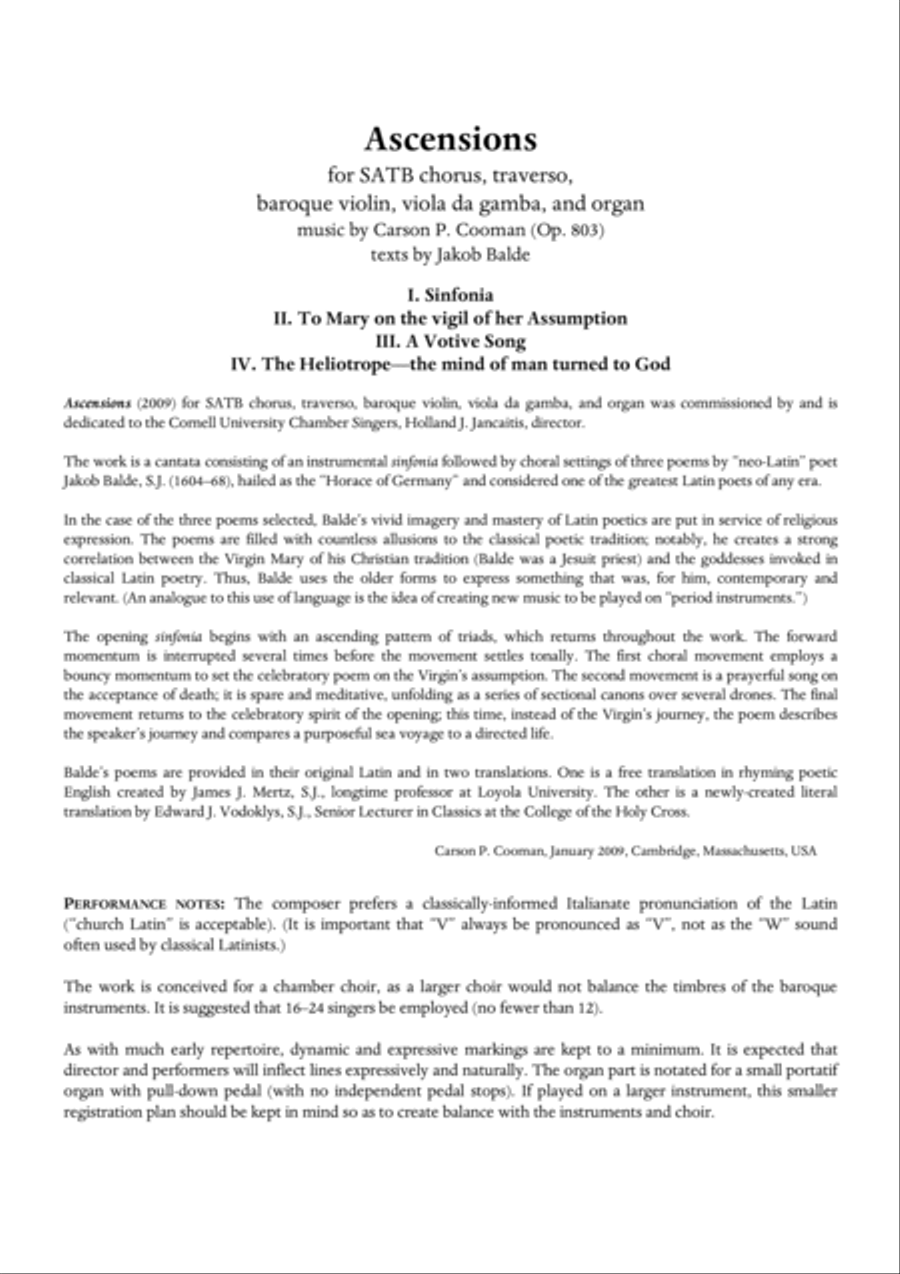Choral Choir (SATB) - Level 5 - Digital Download SKU: A0.535387 Composed by Carson Cooman. Baroque,Contemporary,Sacred. Octavo. 65 pages. Musik Fabrik Music Publishing #3043973. Published by Musik Fabrik Music Publishing (A0.535387). I. SinfoniaII. To Mary on the vigil of her AssumptionIII. A Votive SongIV. The Heliotrope-the mind of man turned to GodAscensions (2009) for SATB chorus, traverso, baroque violin, viola da gamba, and organ was commissioned by and isdedicated to the Cornell University Chamber Singers, Holland J. Jancaitis, director.The work is a cantata consisting of an instrumental sinfonia followed by choral settings of three poems by neo-Latin poetJakob Balde, S.J. (1604–68), hailed as the Horace of Germany and considered one of the greatest Latin poets of any era.In the case of the three poems selected, Balde’s vivid imagery and mastery of Latin poetics are put in service of religiousexpression. The poems are filled with countless allusions to the classical poetic tradition; notably, he creates a strongcorrelation between the Virgin Mary of his Christian tradition (Balde was a Jesuit priest) and the goddesses invoked inclassical Latin poetry. Thus, Balde uses the older forms to express something that was, for him, contemporary andrelevant. (An analogue to this use of language is the idea of creating new music to be played on period instruments.)The opening sinfonia begins with an ascending pattern of triads, which returns throughout the work. The forwardmomentum is interrupted several times before the movement settles tonally. The first choral movement employs abouncy momentum to set the celebratory poem on the Virgin’s assumption. The second movement is a prayerful song onthe acceptance of death; it is spare and meditative, unfolding as a series of sectional canons over several drones. The finalmovement returns to the celebratory spirit of the opening; this time, instead of the Virgin’s journey, the poem describesthe speaker’s journey and compares a purposeful sea voyage to a directed life.Balde’s poems are provided in their original Latin and in two translations. One is a free translation in rhyming poeticEnglish created by James J. Mertz, S.J., longtime professor at Loyola University. The other is a newly-created literaltranslation by Edward J. Vodoklys, S.J., Senior Lecturer in Classics at the College of the Holy Cross.Carson P. Cooman, January 2009, Cambridge, Massachusetts, USAPERFORMANCE NOTES: The composer prefers a classically-informed Italianate pronunciation of the Latin(church Latin is acceptable). (It is important that V always be pronounced as V, not as the W soundoften used by classical Latinists.)The work is conceived for a chamber choir, as a larger choir would not balance the timbres of the baroqueinstruments. It is suggested that 16–24 singers be employed (no fewer than 12).As with much early repertoire, dynamic and expressive markings are kept to a minimum. It is expected thatdirector and performers will inflect lines expressively and naturally. The organ part is notated for a small portatiforgan with pull-down pedal (with no independent pedal stops). If played on a larger instrument, this smallerregistration plan should be kept in mind so as to create balance with the instruments and choir
